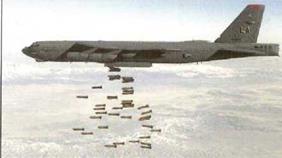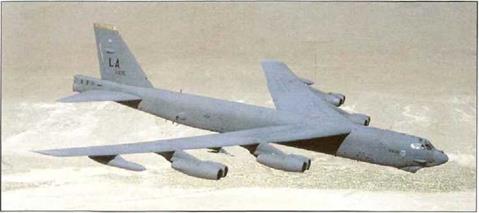Boeing B-52 Stratofortress
|
 |
 |
|
T |
he first B-52 Stratofortresses rolled off the Boeing production. ins in 1952, and from then until 1962 a total of 744 were built. The B-52 was the backbone of Strategic Air Command (SAC) until 1992, when the assets and tasks of SAC and TAG were merged no the newly-established Air Combat Command. Today only one version of the oomber remains in service, the B-52H. The USAF Inventory stands at 94 aircraft, but they have a striking power out of all proportion to their number.
The B-52 is the only USAF aircraft cleared to carry all the nuclear and conventional weapons in the Air Force arsenal. The B-52 was designed as a nuclear bomber and, alongside the B-2, it is still tasked with this strategic strike mission – using free-fall nuclear bombs or cruise-missiles. Because of its immense range and heavy load-carrying ability the В-52Я has now adopted a range of conventional roles, including anti-shipping attacks, mine-laying, area bombing and long-range precision stand-off attacks. B-52s fired some of the first shots of Operation Desert Storm, and flew what became the longest combat mission in aviation history, on the first night of operations in 1991, Seven B-52Gs attacked targets in Iraq using a new version of the Air-Launched Cruise Missile, the AGM-86C, with a high-explosive warhead. This weapon gave the B-52 a completely new precision attack capability, which has now been transferred to the B-52H. The last B-52Gs were retired in March 1994.
The superior conventional weapons capability of the B-52G was transferred to the В 52H under the CMUP (Conventional Mission Upgrade Program) effort. Inside the main bomb-bay the B-52 is fitted with the Common Stores Rotary Launcher which can carry four B28 nuciear bombs, eight B61 or B83 nuclear bombs or eight AGM-86B/C cruise missiles. Another 12 cruise missiles can be carried externally. Depending on the underwing pylon configuration, up to 51 750-lb bombs can be carried – 24 under the wing and 27 in the bomb-bay. The B-52H can also carry AGM-84 Harpoon anti-ship missiles, AGM-142A Have Nap stand-off attack missiles, Paveway II laser-guided bombs and Ouickstrike mines.
The USAF currently has two active Bomb Wings (a total of four squadrons) and single Air Force Reserve Wing (one squadron) equipped with the B-52H. In early 2001, Boeing submitted an unsolicited proposal to the USAF to re-engine all the remaining B-52Hs. The bombers’ eight TF-33 turbofans would be replaced by four more modem Rolls Royce (Allison) RB-211-535 turbofans.
This 2nd Bomb Wing B-52H is dropping a load of 750-lb M117 bombs. A B-52H can carry up to 5І MH7s, totalling some 38,250-lb (17,350-kg) of high-explosive.
 |
In August 1981 McDonnell Douglas was chosen to develop the USAF’s C-X requirement for a new heavy cargo transport, to replace the C-141 Starlit ter. The new aircraft had to be capable of carrying outsize loads, such as the M1 tank and combat helicopters, while retaining a tactical operations capability, including LAPES drops and short landings into austere strips.
The design of the resulting C-17A adopted a classic military transport configuration with a high – mounted supercritical wing, a rear-fuselage loading ramp and undercarriage housings on each side of the fuselage. However, it incorporates such advanced features as winglets, high-performance turbofans (military versions of the Boeing 757 s PW2040) and an all-digital fly-by-wire control system. Short-field performance is aided by an externally – blown flap system and thrust reversers.
The C-1 7 can be configured for cargo, paratroops, combat troops, hospital litter patients, or combinations of all these. For strategic airlift, it can carry 202 personnel, or 18 standard 463L pallets. Typical loads include two М2 Bradley AFVs. two 5-ton 8×8 trucks with trailers, three AH-64 Apache helicopters or six OH-58D helicopters The C-17 can air-drop up to 102 paratroops or platform loads
The C-17 has impressive short-field capabilities, thanks to its high-performance wing (for short takeoffs) and thrust-reverseis (for short landings),
of up to 49895 kg (110,000 lb). The Internal cargo loading system Is fully mechanised for operation by a single loadmaster.
The C-17 endured a turbulent development period and came close to cancellation on several occasions, due largely to cost overruns and technical difficulties. Plans to acquire 210 USAF aircraft have been revised downwards to just 120. The first prototype flew on 15 September 1991, followed by the first initial production C-17A on 18 May 1992. On 5 February 1993 the aircraft was renamed as the C-17A Globemaster III and the first example was delivered to an operational USAF unit on 14 June 1993 On 17 January 1995, the 17th Airlift Squadron at Charleston AFB, was declared operationally ready for worldwide missions’. In 1997 the C-17 became a product of the Boeing Company, when McDonnell Douglas was taken over in August that year.
The C-17 won its operational spurs during Operation Joint Endeavor, supporting peacekeeping in Bosnia, and Operation Allied Force in Kosovo, Britain’s Royal Air Force intends to lease four C-17s from 2001 onwards, to provide much-needed strategic airlift capability. By March 2001 the USAF had taken delivery of 73 C-17As.

|












